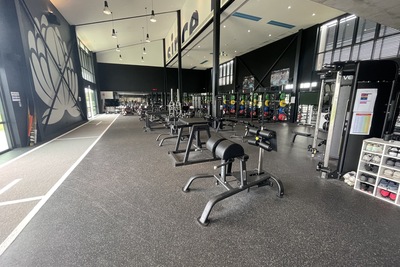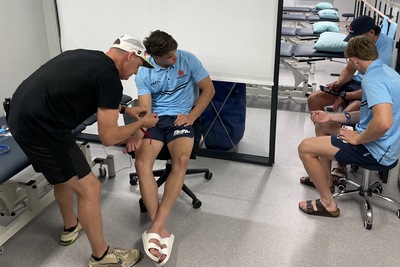We've teamed up with the New South Wales Waratahs to help ensure that they're properly fueled and hydrated during the course of the Super Rugby Season.
The players can face brutal temperatures as matches take place between February and June in the Southern Hemisphere and we caught up with the Waratahs' Head of Performance, Nick Lumley, to find out how they get the squad ready for match day...
Hi Nick, the Waratahs are gearing up for a big 2023 Super Rugby season. What's been the focus for you during pre-season?
We address players' strength and conditioning limitations and also technical and tactical ones during this period. There won't be a lot of cross-training during this time, other than using Wattbikes for our body composition training.
So, we've spent a lot of time in the weights room this year due to the age and training history of the majority of our squad, alongside a high volume of rugby content.

And once the season is underway, what does a typical weekly training schedule look like building into a matchday on Saturday?
Sunday: a day off. We encourage the players to spend time away from rugby, but do something active - for example, going for a swim at one of the many beaches is popular here in Sydney - and we try to eat three good meals plus at least a couple of snacks.
Monday: the morning will be a rotation between rugby meetings, medical screenings and upper body weights (typically 45 minutes of each). There will be a 60-minute team meeting and a 45-60-minute field session that's very light. Most players will finish the day in a recovery bath or sauna.
Tuesday: this is a big working day. 60 minutes of rugby and 60 minutes of full body strength in the gym in the morning, and then a further 60-75 minutes of rugby in the afternoon. There will likely to be some contact work on this day and some players will finish the day back in the gym for 20 minutes before hitting the sauna.
Wednesday: a recovery day, although lots of players will come in and do a 30-minute weight session in their own time and use the recovery pools and sauna.
Thursday: similar to Tuesday but shorter. 45 minutes of rugby and 45 minutes of explosive weights followed by 45 minutes of rugby, which will be fast. Then massage after lunch and recovery in ice or the sauna.
Friday: short day. 30-minute field session involving a jog through and we’ll promote ice for all players post-training.
Saturday: match day.
And when it comes to hydration for match day, how do you make sure 15 players (plus substitutes) are properly hydrated in what can be brutally hot conditions?
We try to individualise as many aspects of our program as possible but there’s always a logistical constraint on what we can deliver. So, we have a generic sodium loading protocol using the PH 1500 electrolyte tablets around two hours before kick-off that we implement across the match day squad due to the heat we play in.
In terms of hydration during matches, the Sweat Test for each player has been invaluable as it's pointed us in the direction of the players who we should pay extra attention to because they sit outside the 'average' with regards to their sweat sodium losses and we're able to target them with stronger sodium-based drinks at half time.

And what are the players eating pre-match?
We encourage players to have good pre-match routines and understand what works for them and then we do our best to ensure access to the right foods. There’s obviously an educational aspect too with regard to what the science world tells us is the optimal feeding strategy.
We taper training into a game and use a four meal loading strategy for carbohydrates, starting the night before.
We try and avoid foods with excessive fat and fibre due to their impact on digestion rates and provide lean high protein and carbs. White pasta and chicken are pretty common staples for us as they tick all of the right boxes.
We work with a lot of endurance athletes who aim to hit certain amounts of carbohydrate, electrolytes and fluid during events. Do the Waratahs players have similar targets?
Rugby is more of an intermittent high intensity sport that takes places over a prolonged period, so we have a big focus on what the players do before matches. We're pretty good at turning up to games well fed, hydrated and with enough sodium in our system.
In the last three or four years I’ve focused more attention on what we consume during games because evidence tells us that football and rugby codes can gain a performance enhancement by maintaining blood sugar (spare muscle glycogen) through carbohydrate feeding during a game.
So, we use the PF 60 Energy Drink Mix in our drinks bottles during the warm-up and during the game, and we make up 500ml (16oz) of this solution and ice it for players to drink at half-time.
We also use the PF 30 Gels and PF 30 Caffeine Gels for post-warm up before kick-off and then again at half-time. We have a couple of players who will also consume a gel on the field in a break of play.
It's interesting to note that the players use the caffeine gels. Is there a big focus on caffeine in rugby?
We are avid users of caffeine and we encourage our players to use it if they have a tried and tested protocol due to the weight of the evidence supporting its ergogenic effect.
Our advice is always to aim for around 3mg of caffeine per kilogram of bodyweight as a serving on match days. In training, it's used more sparingly and on an individual basis.

And when it comes to post-match, how do you approach recovery?
In 2023, the best form of recovery is still sleep, hydration, nutrition and a periodised training plan.
We try to provide 30g high quality protein immediately post-match, along with omega 3, muti-vitamin, creatine monohydrate and a dose of anti-oxidants. This will be in the form of a changing room drink we mix up with a couple of additional supplements.
From here on we promote high protein content meals every three hours for the next 48 hours. We don’t push carbohydrate as strongly in some as we're under no time pressure to restore muscle glycogen (we do push it players who struggle to maintain weight). In my experience, there aren't many rugby players who struggle to get their hands on sufficient carbohydrate post-game anyway!
Our focus is always on regular doses of protein for all players to promote tissue healing and muscle protein synthesis.
We’ll have a day off feet after a game and another day that's very light but we still do some meaningful work. And then three days post-game we'll train hard before another rest day. Where you structure your loaded days and your light days is key in my experience.
And finally, what would be the No.1 thing that you think endurance athletes can learn from how the Waratahs approach training?
That's a good question. I think the biggest thing that professional sports do well, which I haven’t always seen done as effectively in endurance sports, is take an holistic approach to training.
With the luxury of doing this for a living as part of a pro rugby team, you have access to resources, a team of support staff and the time to plan in this detail, which of course most recreational athletes won’t have access too.
For a triathlete, planning training loads needs to take into account a whole range of factors. You need to plan the training loads of gym, track, pool, and bike sessions, and monitor progress and adaptation to training. You also need to make sure that dietary interventions complement the training ones, whilst looking into nutrition, recovery interventions, and sleep. All of this needs to be carried out with a good understanding of an individual's strength and weaknesses.
Ultimately, these factors will all interact with each other.